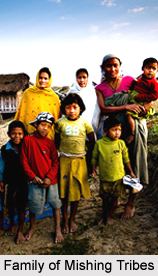 The Mishings tribes, also known as Miris, mainly reside in the north eastern region of India. During the medieval period they descended to the valleys and currently inhabit the districts of Dibrugarh, Tinsukia, Jorhat, Sibsagar, Darang, North Lakhimpur, Dhemaji, Sonipur and Golaghat. Presently the Mishings form a significant part of the tribal population. They have their separate society, dwellings, socio-religious festivals, social behaviour, dressing pattern, language, family system and language.
The Mishings tribes, also known as Miris, mainly reside in the north eastern region of India. During the medieval period they descended to the valleys and currently inhabit the districts of Dibrugarh, Tinsukia, Jorhat, Sibsagar, Darang, North Lakhimpur, Dhemaji, Sonipur and Golaghat. Presently the Mishings form a significant part of the tribal population. They have their separate society, dwellings, socio-religious festivals, social behaviour, dressing pattern, language, family system and language.
Family of Mishing Tribes
The Mishings consists of several loosely knitted groups and each group comprises of several clans of close blood relation. Every clan bears a particular title or surname. They practice clan exogamy. Monogamy is the common form of marriage though polygamy is also practised among them. The Mishings belong to the patriarchal society and the line of descent is traced through the father. The sons inherit the family property. Cross-cousin marriage is prevalent among the Mishings. The Mishing tribes generally reside in nuclear families where the husband is the head of the family and exercises authority. The head of the family maintains and exerts control over other family members. This helps in strengthening the social system. `Daglek`, `Rig Bo` are the important co-operative institutions of the Mishings. The head of the `Kebang`, the chief administrative unit is known as `Gam`.
Village House of Mishing Tribes
The Mishing Tribes usually live in small huts on the banks of rivers. The houses have an elevated platform known as `Chang ghar.` Their dwellings have thatched roofs and stilted floor generally constructed with flattened bamboo. The houses are usually built four to five feet above the ground. Affluent people built their houses with wood while others use bamboos. Houses where joint families reside are usually huge in size and have several fireplaces. In the front side of the house a portion of platform is kept open to be used as a verandah. A raised area of the house is usually extended to serve the purpose of cleaning utensils, straining of rice etc. The houses have two doors, one at the front and other at the back. Sometimes a third door is also constructed that might open to an exposed platform. The space is used for sitting, lying down and also for drying paddy grains. Presently the houses are not made according to the traditional style.
Occupation of Mishing Tribes
 Mishing tribes are dependent on agriculture for earning their livelihood. They practice permanent cultivation though the practice of shifting cultivation has not been fully given up. The crops that are mainly grown by them are pulses, paddy, maize and mustard and varieties of vegetables. They also cultivate different varieties of rice as well. They are also considered as expert fishermen. The women of the community also contribute to the family income by rearing pigs, fowls and goats.
Mishing tribes are dependent on agriculture for earning their livelihood. They practice permanent cultivation though the practice of shifting cultivation has not been fully given up. The crops that are mainly grown by them are pulses, paddy, maize and mustard and varieties of vegetables. They also cultivate different varieties of rice as well. They are also considered as expert fishermen. The women of the community also contribute to the family income by rearing pigs, fowls and goats.
Marriage System of Mishing Tribes
The marriage system among the Mishing tribes incorporates several rites and rituals. Marriage is forbidden within the same `Gumin,` a Mishing social organisation. The Mishings follow the custom of `Magbo-dugnam` where the probable bridegroom renders service in the house of his would be bride. Songs and dances are an essential feature of Mishing marriage. Widow re-marriage is practised but child marriage is prohibited. Da:ro Midang, Kumsu-jo:su and Dugla la:nam are the three important types of marriages of the Mishings.
Funeral Rites of Mishing Tribes
The Mishings follow certain unique traditional funeral rites. They pour `Apong` or water through a conical leaf in the mouth of the dying person. They wrap the dead body first with a cloth and then with a mat and then burry them. `Ago-golung` is a burial ground of the Mishings. The family members of the deceased observe certain rituals until the purificatory rites are performed. `Usi` or `Uram-Apin` `Dodgang` are few special purificatory practises where the family members wail loudly in the presence of other people. They also sing the kaban, a song of lament.
















